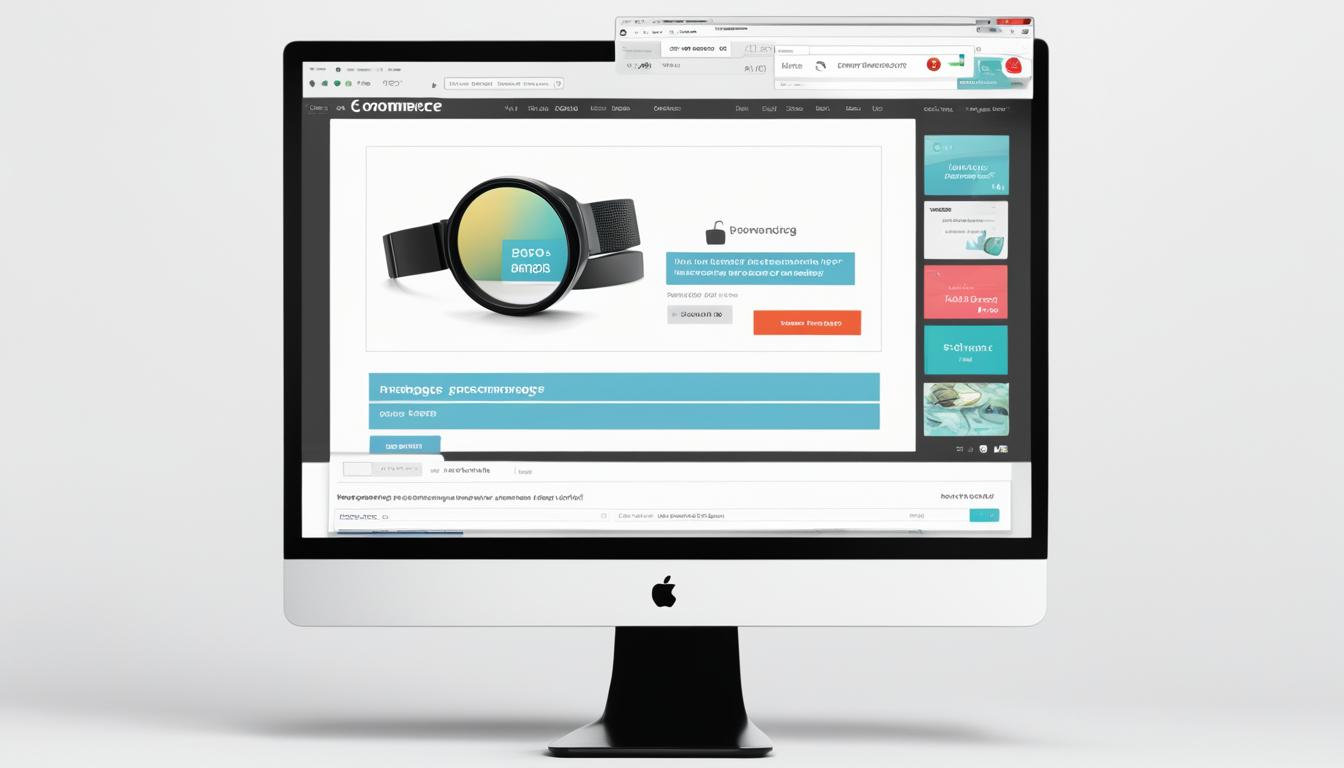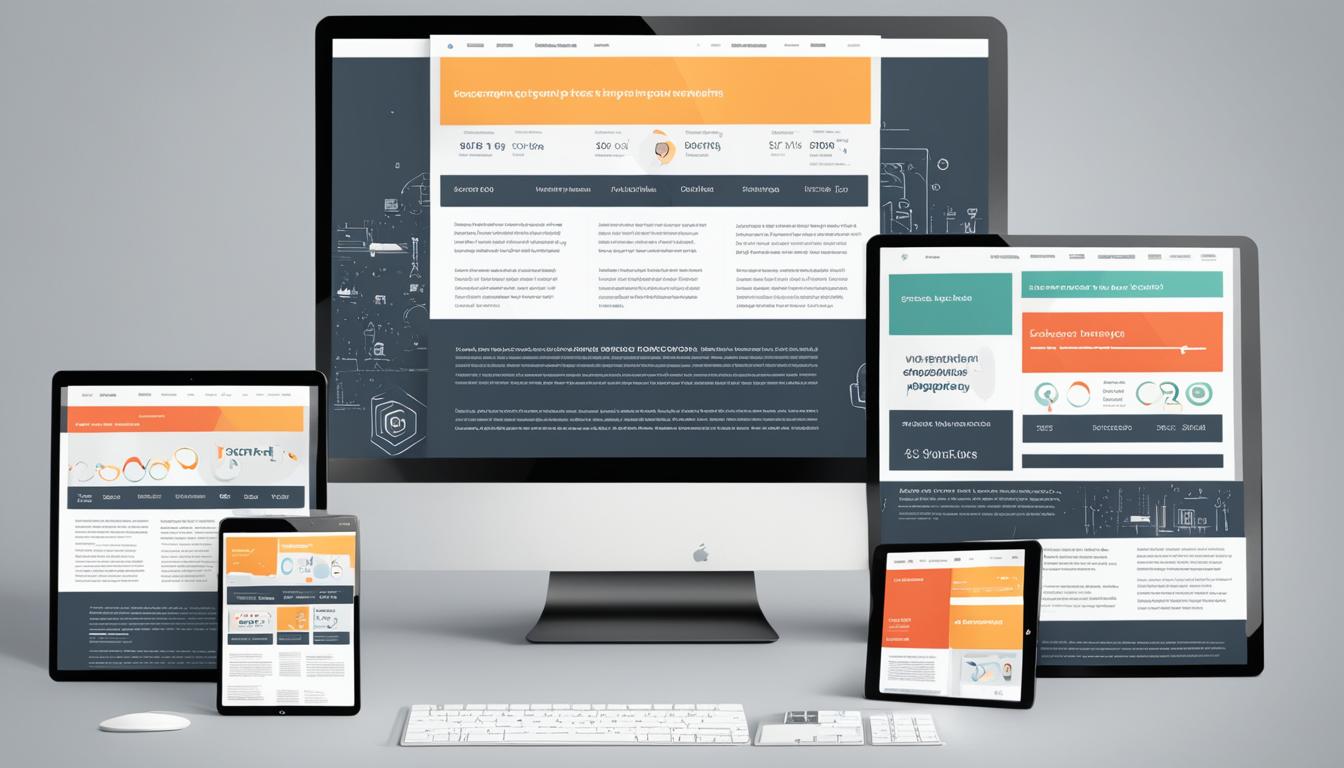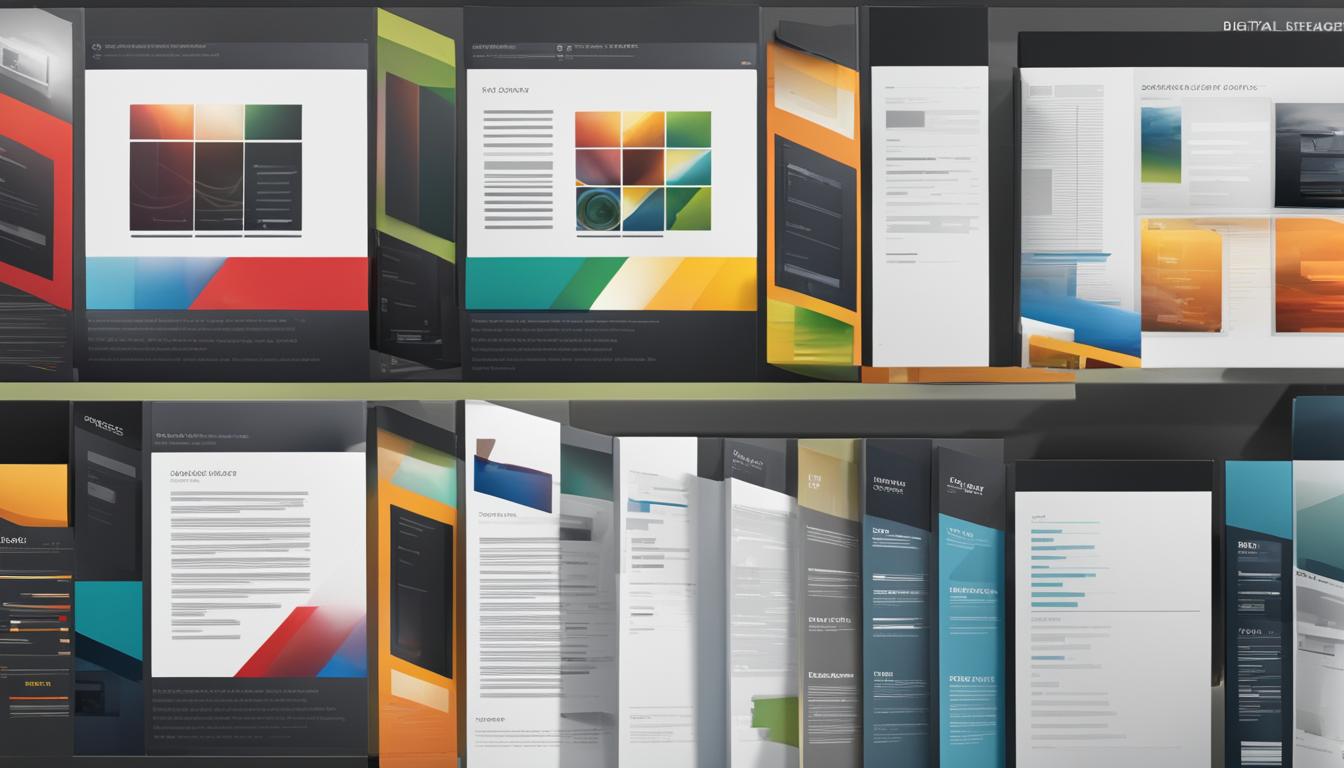Hey there! Welcome to my blog post on image optimization for e-commerce SEO. In today’s digital world, optimizing your product images is essential to attract more visitors to your online store and boost your search engine rankings. So, let’s dive right in and explore the best practices and techniques for optimizing your images for SEO.
Images are a powerful tool for driving web traffic, but search engine spiders can’t see them the way we do. That’s why it’s crucial to optimize your product images to make them visible and attractive to search engines. By implementing a few simple strategies, you can significantly improve your website’s performance and increase your chances of getting noticed by potential customers.
Key Takeaways:
- Optimizing your product images is vital for e-commerce SEO.
- Search engine spiders can’t see images, so optimization techniques are necessary.
- Strategies like optimizing image file names, adding alt text, and resizing image sizes can enhance search engine visibility.
- Choosing the right file types and providing an image sitemap also contribute to image optimization for e-commerce SEO.
- Optimized images can lead to higher web traffic, better search engine rankings, and increased conversions.
Why is Image Optimization Important for E-commerce SEO?
Image optimization plays a crucial role in the world of e-commerce SEO. It is not just about making your website visually appealing, but it goes beyond that. It directly impacts the performance of your website, search engine rankings, and the overall user experience. Let me explain why image optimization should be a priority for your e-commerce business.
The Importance of Image Optimization for E-commerce SEO
1. Improved Website Performance: Large and unoptimized images can significantly slow down your website, causing longer load times. This has a negative impact on user experience and can lead to higher bounce rates. By optimizing your images, you can enhance page load times, resulting in a faster and smoother website experience for your visitors.
2. Boost in Search Engine Rankings: Search engines take into account various factors to determine the rank of a website. One such factor is page load times. Websites with faster load times are more likely to rank higher in search engine results. By optimizing your images and reducing their file size, you can improve your website’s performance and increase the chances of ranking higher in search engine results pages (SERPs).
3. Enhanced User Experience: User experience is a critical aspect of e-commerce. Slow-loading websites frustrate visitors and discourage them from making a purchase. Optimized images help create a seamless and enjoyable browsing experience, keeping your visitors engaged and increasing the likelihood of conversions.
The Impact of Image File Size and Page Load Times
When it comes to image optimization, file size and page load times are key considerations. Large image files take longer to load, which can lead to slower page load times. Slow websites not only affect user experience but also impact search engine rankings. According to research, 40% of visitors will abandon a website if it takes more than three seconds to load. Optimizing image file size helps reduce load times, improve website performance, and retain more visitors.
The Relationship Between Image Optimization and Search Engine Rankings
Search engines consider the overall user experience when evaluating websites. Websites that provide a fast and smooth experience are more likely to rank higher in search engine results. Image optimization plays a crucial role in improving website performance and user experience, both of which contribute to higher search engine rankings. By optimizing your images, you can boost your chances of appearing on the first page of search engine results.
The Impact of Image Optimization on User Experience
Optimized images contribute to a positive user experience, providing several benefits:
- Reduced bounce rates: Users are more likely to stay on your website and explore further if they encounter fast page load times and appealing visuals.
- Increased engagement: When users have a positive experience navigating your website, they are more likely to engage with your content, products, and brand.
- Improved conversions: A smooth and visually pleasing website enhances the chances of converting visitors into loyal customers.
Tips for Optimizing Product Images for E-commerce SEO

When it comes to e-commerce SEO, optimizing your product images is essential for improving search engine visibility. Here are some tips to help you optimize your product images and boost your website’s performance:
1. Image File Names
When naming your image files, use descriptive and keyword-rich names instead of generic ones. This helps search engines understand what your images are about and improves their chances of ranking higher in search results. For example, instead of naming an image “IMG001.jpg,” use a name like “black-leather-handbag.jpg” to better describe the image.
2. Alt Text
Include relevant keywords in the alt text of your images. Alt text provides alternative text for users who have visual impairments and helps search engines understand the content of your images. Be descriptive but concise when writing alt text, and avoid keyword stuffing. For example, instead of using alt text like “handbag” or “product image,” use alt text like “black leather handbag with gold accents.”
3. Image Sizes
Keeping image sizes small is crucial for improving page load times. Large images can slow down your website and negatively impact user experience. Resize your product images to the appropriate dimensions and compress them without compromising quality. This reduces file size and ensures faster loading times. You can use image optimization tools to resize and compress your images efficiently.
4. Image File Types
Choosing the right file types for your images is important for both website performance and SEO. The most common image file types are JPEG and PNG. JPEG files are ideal for photographs and images with complex colors, while PNG files are better for images with transparency or simple graphics. Use the appropriate file type based on the content of your images.
5. Image Sitemap
Providing an image sitemap helps search engines discover and index the hard-to-find images on your website. An image sitemap is a separate XML file that contains information about the images on your site, such as their location and metadata. Submitting an image sitemap to search engines can improve image visibility and increase the chances of your images appearing in relevant search results.
By following these tips for optimizing your product images, you can improve the visibility of your e-commerce website in search engine rankings and enhance the overall user experience.
| Optimization Technique | Benefits |
|---|---|
| Image File Names | Improves search engine understanding and visibility |
| Alt Text | Enhances accessibility and search engine understanding |
| Image Sizes | Reduces page load times and improves user experience |
| Image File Types | Optimizes image quality and compatibility |
| Image Sitemap | Increases image discoverability and indexing |
The Impact of Image Optimization on Website Speed and Conversions

When it comes to website speed and conversions, image optimization plays a crucial role. In fact, slow-loading websites, often caused by large and unoptimized images, can have a significant impact on both the speed of your site and your conversion rates.
Research has shown that even a mere two-second delay in page load times can increase the bounce rate by a staggering 103%. This means that when visitors encounter slow-loading pages, they are more likely to leave without exploring further or making a purchase. Moreover, pages with longer load times tend to have higher bounce rates and lower average time on page, further hampering engagement and conversions.
By taking the time to optimize your images, you can greatly improve website speed, enhance user experience, and boost your conversion rates. Optimized images ensure that your website loads quickly, capturing and retaining the attention of your visitors.
“A two-second delay in page load times can increase the bounce rate by 103%.”
An optimized website with faster load times creates a seamless browsing experience, keeping users engaged and encouraging them to explore more of what your site has to offer. This increased engagement can lead to higher conversion rates, as users spend more time on your site and are more likely to convert into paying customers.
So, how can you optimize your images to improve website speed and conversions? Let’s take a look at a few key strategies:
- Compressing image file sizes to reduce load times while maintaining image quality
- Resizing images to appropriate dimensions for web display
- Choosing the right file types, such as JPEG or PNG, based on the image content
- Implementing browser caching to enable faster page loading for returning visitors
By implementing these image optimization techniques, you can significantly improve your website’s speed, minimize bounce rates, and increase the average time spent on each page. Moreover, these optimizations contribute to a smoother user experience, fostering trust and encouraging visitors to take the desired actions on your site.
Ultimately, the impact of image optimization on website speed and conversions cannot be overstated. It is a critical component of your overall SEO strategy, as it directly influences user satisfaction and engagement, leading to higher conversion rates and business success.
| Effect | Image Optimization Impact |
|---|---|
| Bounce Rate | Decreases by minimizing slow-loading pages |
| Average Time on Page | Increases as users spend more time engaging with optimized content |
| Conversion Rate | Improves due to enhanced user experience and faster page load times |
Best Practices for Image Optimization in E-commerce SEO
When it comes to image optimization in e-commerce SEO, following best practices is essential. By implementing these techniques, you can ensure that your images are optimized for search engines and provide the best user experience. Here are some key practices to consider:
1. Correctly Size Images
Optimizing the size of your images is crucial for website performance. Large images can significantly increase page load times, negatively impacting user experience and search engine rankings. Use image editing tools or resize images in HTML to make sure they are the appropriate dimensions for your webpage.
2. Compress Images to Reduce File Size
Image compression is an effective way to reduce file size without compromising image quality. By compressing images, you can improve page load times and enhance user experience. Use image compression tools or plugins to automatically compress images without sacrificing visual appeal.
3. Choose the Right File Format
Selecting the correct file format is essential for image optimization. The most common file formats for web images are JPEG and PNG. JPEG is best suited for photographs and complex images, while PNG is ideal for simple graphics and images with transparent backgrounds. Choose the appropriate file format to maintain image quality while minimizing file size.
4. Implement Browser Caching
Browser caching allows visitors to store static files, including images, in their web browser. By enabling browser caching, you can reduce page load times for returning visitors, as their browser can retrieve cached files instead of downloading them again. Implement caching headers or use caching plugins to take advantage of this optimization technique.
5. Use Lazy Loading
Lazy loading is a technique that loads images only when they are visible on the user’s screen. This approach can significantly improve page load times, especially for websites with multiple images. Implement lazy loading using JavaScript libraries or plugins to prioritize content and prevent unnecessary loading of off-screen images.
6. Implement Responsive Images
Responsive images adapt to different screen sizes and resolutions, ensuring optimal display on various devices. By using responsive images, you can improve the mobile user experience and enhance your website’s SEO. Use HTML and CSS techniques, such as srcset and media queries, to implement responsive images effectively.
7. Follow Image SEO Best Practices
To optimize images for search engines, it’s essential to follow image SEO best practices. This includes using descriptive file names that include relevant keywords, writing concise and SEO-friendly alt text, and providing captions or context where appropriate. By optimizing these elements, you can improve image discoverability and enhance your website’s visibility in search engine results.
| Image Optimization Best Practices | Description |
|---|---|
| Correctly Size Images | Resize images to appropriate dimensions for your webpages. |
| Compress Images | Reduce file size without compromising image quality. |
| Choose the Right File Format | Select the appropriate format for your images (e.g., JPEG, PNG). |
| Implement Browser Caching | Enable caching to store static files in users’ browsers. |
| Use Lazy Loading | Load images only when they become visible on the user’s screen. |
| Implement Responsive Images | Adapt images to different screen sizes and resolutions. |
| Follow Image SEO Best Practices | Optimize image file names, alt text, and captions for SEO. |
Image Optimization Tools for E-commerce SEO

When it comes to image optimization for e-commerce SEO, having the right tools can make a significant difference. Here are some essential tools that can assist you in optimizing your images:
1. Image Compression Tools
Image compression tools are crucial for reducing the file size of your images without compromising their quality. These tools help optimize your images for faster loading times, which can improve your website’s SEO performance. Popular image compression tools include:
- TinyPNG
- CompressJPEG
- ImageOptim
2. Image Resizing Tools
Image resizing tools allow you to adjust the dimensions of your images to fit various devices and screen sizes. By resizing your images, you can ensure optimal viewing experiences across different platforms. Consider using tools such as:
- Adobe Photoshop
- Canva
- ResizeImage.net
3. Image CDN
An Image CDN (Content Delivery Network) helps optimize image delivery by distributing your images across multiple servers worldwide. By leveraging the power of a CDN, you can improve image loading times, reduce bandwidth usage, and enhance the overall user experience. Some popular Image CDNs include:
- Cloudinary
- KeyCDN
- Amazon CloudFront
4. WordPress Plugins
If you’re using WordPress for your e-commerce website, there are several plugins available that can streamline the image optimization process. These plugins offer features like smart compression, WebP conversion, lazy loading, and optimization based on Google recommendations. Consider using plugins such as:
- Imagify
- Smush
- ShortPixel
With these powerful image optimization tools at your disposal, you can ensure that your e-commerce website’s images are optimized for SEO, resulting in better user experiences, faster loading times, and improved search engine rankings.
The Role of Image Optimization in Improving Website Performance and SEO

Image optimization plays a crucial role in improving website performance and SEO. By optimizing your images, you can enhance page load times, resulting in a better user experience and improved search engine rankings. But why is it so important? Let’s take a closer look.
The Impact on Website Performance
When it comes to website performance, every second matters. Slow-loading pages can frustrate users, leading to higher bounce rates and lower engagement. Optimized images play a significant role in reducing page load times, ensuring that your website performs at its best.
Did you know? A one-second delay in page load time can result in a 7% reduction in conversions.
Optimized images have smaller file sizes, which means they take less time to download and display. This leads to faster page load times, allowing users to access your content more quickly. As a result, your website can provide a seamless browsing experience that keeps users engaged and encourages them to stay longer.
The SEO Benefits
Image optimization not only improves website performance but also has a positive impact on your search engine rankings. Search engines consider various factors when ranking websites, including page load times and user experience. By optimizing your images, you can meet these criteria and improve your chances of ranking higher in search engine results.
When search engine spiders crawl your website, they rely on the information provided by your optimized images to understand your content. Adding descriptive alt text to your images helps search engines comprehend the context and relevance of your webpages, ensuring that your content appears in relevant search results.
Aligning with Core Web Vitals
Image optimization aligns with Google’s Core Web Vitals, a set of metrics that measure the overall user experience of websites. These metrics include page load time, largest contentful paint (LCP), and cumulative layout shift (CLS).
Optimized images contribute to faster page load times, which directly impacts LCP. When your page loads quickly, users can access the most significant content sooner, leading to a more satisfying user experience. Additionally, optimized images and proper image sizing can prevent layout shifts, ensuring that your webpages remain visually stable.
By prioritizing image optimization and meeting the Core Web Vitals requirements, you can improve your website’s performance, enhance user experience, and increase your chances of ranking higher in search engine results.
| Benefits of Image Optimization | Impact |
|---|---|
| Improved Website Performance | Faster page load times, lower bounce rates, higher user engagement |
| Enhanced SEO | Better search engine rankings, increased visibility in search results |
| Aligning with Core Web Vitals | Improved user experience, higher chances of ranking higher in search engines |
Conclusion
Image optimization is an essential aspect of e-commerce SEO. By implementing various image optimization techniques, such as optimizing file names, adding alt text, resizing image sizes, and choosing the right file types, you can significantly improve your website’s performance and enhance search engine rankings.
Optimized product images play a crucial role in enhancing user experience, increasing conversions, and driving more traffic to your e-commerce store. By ensuring that your images are properly optimized, you can captivate your audience and encourage them to stay longer on your website, ultimately leading to higher engagement and increased sales.
By prioritizing image optimization, you improve website performance, making sure that your pages load quickly and efficiently. This not only benefits user experience but also aligns with search engine ranking factors. Search engines reward websites with faster page load times, helping you gain better visibility and organic traffic.
So, don’t overlook the power of image optimization in your e-commerce SEO strategy. Start implementing the best practices mentioned in this article today to unlock the full potential of your product images and achieve improved website performance, higher search engine rankings, and ultimately, business success.










